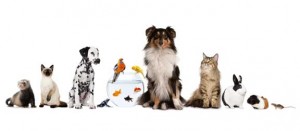If there’s one thing our pets love, it’s eating things they shouldn’t. Pet parents often catch their mischievous fur babies pawing at bags of fertilizer or open food containers. Curiosity gets the better of them, leaving you to anxiously await their prognosis in the vet hospital’s waiting room. Stay one step ahead of your pet by identifying and locking away poisonous substances in their environment. Here are the most common toxic products that affect cats and dogs.

Pets Are Great Companions
Garden products: Insecticides and fertilizer emit potent smells that attract curious noses. The chemicals in garden products are good for your garden, but not for your pet! They can poison pets and cause intestinal blockages. Keep your furry friend safe by storing these products on high shelves. Follow the product’s instructions and don’t allow pets in the yard or garden until it’s safe to do so.
Rodenticide: Mouse traps and rat bait are common in many households. But not only are they poisonous to rodents, these products are poisonous to cats and dogs, as well. Rodenticides cause internal bleeding, kidney failure and seizures in pets. Severe cases might even prove fatal. Set up rodenticide where your cat or dog can’t get to it.
Home improvement materials: Many pet parents have ongoing DIY projects around the house. Unfortunately, pets can’t help but investigate toxic materials that they shouldn’t. Be sure to clean up paint, glue and spackle once you’re done, as these contain chemicals that can severely poison your pet.
Over-the-counter medications: Some owners attempt to treat their ailing pets with over-the-counter medications designed for humans. Never give a cat or dog human medication because the dosage is too strong for them. Products like ibuprofen and acetaminophen also contain ingredients that aren’t safe for pets. Only give your furry friend medications that have been approved by your vet.
Prescription drugs: You might be shocked to learn that vet-approved medications can poison your pet, too. While veterinary drugs are supposed to help, consuming too much at once can turn deadly. Oral medication tastes good so that your pet will want to eat it. Unfortunately, this can lead to pets swallowing a whole bottle’s worth of pills. Store veterinary drugs in a secure cabinet or pantry to avoid overdoses.
Household cleaners: Pets like to explore strange new substances with their sense of taste. Sprays, antibacterial wipes and detergents create an emergency situation for both cats and dogs. Even if household cleaners are put away, pets can nose into lower cabinets and chew through the bottles. Wipe up spills and lock these products high off the ground.
Chocolate: A lot of your favorite desserts are deadly to pets. For instance, chocolate is extremely toxic for both cats and dogs. This tasty treat contains a compound called theobromine that causes vomiting, diarrhea and excessive urination. When consumed in large amounts, chocolate can lead to a rapid heartbeat, tremors, seizures and eventually death. Keep all chocolatey foods out of your pet’s reach.
Grapes and raisins: Some fruits are a good source of nutrients for cats and dogs. However, grapes are not one of them. Researchers have yet to identify a toxic agent in grapes, but they believe tartaric acid could be the culprit. The first signs of grape toxicity include vomiting, loss of appetite and lethargy. If left untreated, grape toxicity can progress to kidney failure. Avoid feeding grapes to your cat or dog as well as foods that contain raisins or currants.
Xylitol: Xylitol is a natural sweetener often found in sugar-free foods. It’s toxic to cats and dogs because, unlike in humans, the substance is quickly absorbed into the bloodstream. This triggers a sudden release of insulin, which leads to dangerously low blood sugar. Xylitol toxicity may also cause seizures, liver failure and death. Check the ingredient labels on sugar-free foods to see if they contain xylitol. Store foods with xylitol far away from your pets.
Garlic and onions: These common cooking ingredients are poisonous to both cats and dogs. Garlic and onions are part of the allium family, which all share a toxic agent called thiosulfate. Toxicity from these plants causes oxidative damage to red blood cells, otherwise known as hemolytic anemia. You’ll know something’s wrong right away because your pet will exhibit loss of appetite and gastrointestinal upset. If you make homecooked meals for your pet, avoiding putting these ingredients in their food.
Toxins are everywhere in your pet’s environment. Cats and dogs often learn the hard way which substances they’re not supposed to eat. But with the right precautions, you can easily avoid a trip to the emergency clinic. Pets don’t know what’s bad for them—it’s up to you to keep toxins beyond their reach! Article courtesy of Pet Wellness!
